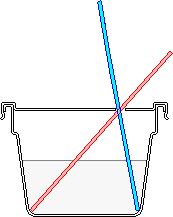The following text has been paraphrased from an instruction leaflet issued by Richard Alabone in October 1996, I neither endorse nor condemn this product or the method of use of it, nor do I have any commercial interest in it.
This simple device can be used for sterilising comb by fumigating with acetic acid in order to kill Nosema spores or can be used to vaporise formic acid.
It is little more than a margarine tub with a slot in it's lid for a wick that can be sized to suit hive volume and the season.
It should only be filled when safely resting on the top bars of the brood frames of the hive being fumigated.
The wick itself is supplied with guide lines so that it may be cut to the size that is appropriate to the volume of the hive that is in use.

After the supers have been removed, for extraction, place the empty reservoir (without lid) on the top bars over the brood nest.
Wear suitable rubber gloves, boots, goggles and a long plastic apron of the "post mortem" type.
Carefully insert 100 ml of 65% acid using a scale on the acid bottle or a glass measuring cylinder. Fit the lid and insert the wick in the correct position according to the season, the position indicated red should be used in Summer and the alternative blue position should be used in Autumn.
Note the acid level reading on the relevant scale.
Do not fill the unit elsewhere and then move it on to the hive as the lid is not sealed and will leak if tilted.
Place an empty super around the Evaporator and fit the crown board, checking that they seal well to prevent acid vapour escaping. Warm air rises from the brood nest to vaporise the acid.
If you use brood and an half remove 3 frames in the top box and put the Evaporator in the gap.
It is beneficial to put insulation over the crown board - 15 mm foam polystyrene insulation board is ideal. Better insulation may be provided by placing a crown board, with a central hole 150 mm square (6" x 6"), on the brood box. Place a wooden or plastic box 175 mm square and 100 mm deep (7" x 7" x 4") over the hole and the evaporator, and then cover with insulation material. This arrangement will also limit excessive comb building. The hive entrance should be wide open.
Monitor mite drop using a varroa floor.
The standard dose of 100 ml should last at least 10 days and the daily evaporation rate, of 10 ml per day, should be checked every few days. Variations in temperature and humidity alter the rate of evaporation from perhaps 7 ml to 18 ml per day. If a larger dose is given initially it will last longer and will do no harm.
After use, the Evaporator and wick should be rinsed thoroughly in water and then dried for re-use.
USING FORMIC ACID
The evaporation rate, and consequent mite mortality, is dependent on several factors:- acid strength, wick area, volume of hive and ambient temperature variation from summer to autumn (up to mid October). By trimming the Beesy wick and setting it in the correct position, variations due to hive volume and ambient temperature are largely nullified. There is sufficient difference between the minimum effective evaporation rate and over-dosing to ensure satisfactory treatment under normal conditions. Acid solution may be 60% or 65%.
Monitor daily evaporation rate, initially every 2 or 3 days, to ensure that it is approximately 10 ml while keeping a note of ambient temperature. Treatment should last for a least 10 days - top up acid if necessary. Mite mortality with formic acid treatment will be only about 50% where the daily evaporation is 4 ml, but with 10 ml per day an average of 80% should be expected per treatment in summer, and 90% in autumn. (The two treatments cause 80% mortality, followed by 90%, thus leaving only 2% of the original mites).
The instructions given are for average conditions, but wick size may require altering to suit local weather conditions, colony size, hive exposure to wind and sun, etc. Vary the evaporation rate by increasing or decreasing the wick size. Monitoring natural mite drop throughout the season will indicate any severe reinfestation from a local collapsing colony and, therefore, re-treatment will be necessary. If mites are numerous in spring, an extra treatment may be given before the first flow using the autumn wick position. This will only produce an effective dose when the ambient temperature is over 10°C and the bees are not clustering.
Although formic is not an aggressive acid the vapour is corrosive:- therefore an increased rate of corrosion will occur on metals within the hive. Always remove the queen excluder and where, possible use stainless steel wire in foundation.
VARROA DETECTION
Fill the Evaporator With only 10 ml of acid and count the mite drop through a screen, after 24 hours.
SAFETY INSTRUCTIONS
Wear rubber safety gloves, goggles and boots when handling formic acid. Its use is not without danger - acid burns. Have a bucket or bottle of water available to wash off any splashes. Never use near children or pets. Do not inhale vapour. Use a 1 litre acid bottle for filling the reservoir and only when in place over the brood nest. Do not handle an evaporator containing acid. Never use acid of higher than 65% solution strength.
Formic acid is used as a "non medicinal curative substance" in UK... In other countries you need to check whether or not it's use is legal.
The Beesy Evaporator is protected under DESIGN RIGHT dated 1.10.96.
The product and spare wicks can be obtained from:- BEESY LTD... Address and Phone number via Beesy Products link.